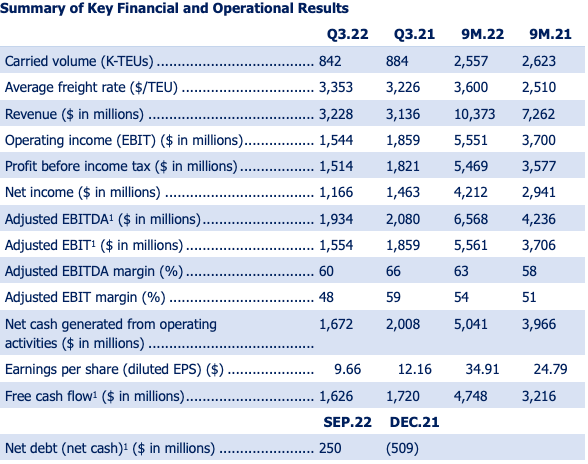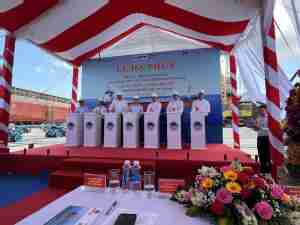Third Quarter 2022 Highlights
- Net income for the third quarter was $1.17 billion (compared to $1.46 billion in the third quarter of 2021), or $9.66 per diluted share (compared to $12.16 in the third quarter of 2021)
- Adjusted EBITDA for the third quarter was $1.93 billion, a year-over-year decrease of 7%
- Operating income (EBIT) for the third quarter was $1.54 billion, a year-over-year decrease of 17%
- Revenues for the third quarter were $3.23 billion, a year-over-year increase of 3%
- Carried volume in the third quarter was 842 thousand TEUs, a year-over-year decrease of 5%
- The average freight rate per TEU in the third quarter was $3,353, a year-over-year increase of 4%
- Net leverage1 ratio of 0.0x on September 30, 2022, similar to December 31, 2021
- Declared dividend of approximately $354 million, or $2.95 per share, representing approximately 30% of third-quarter net income
- Announced a ten-year liquefied natural gas (LNG) purchase agreement with Shell to supply the LNG-fueled vessels that will be deployed on ZIM's Asia to USEC trade
Eli Glickman, ZIM President & CEO, stated, “Our third quarter and nine-month 2022 results reflect outstanding execution and elevated profitability. While market conditions remained volatile, we delivered strong EBITDA and EBIT margins and generated a net income of $1.17 billion in the third quarter. Given our significant cash generation, and consistent with our prioritization of returning capital to shareholders, we have declared this year over $1.26 billion, or $10.55 per share, in dividends on account of 2022 results, including a Q3 dividend of approximately $354 million, or $2.95 per share.”
Mr. Glickman added, “Driven by macroeconomic and geopolitical uncertainties, the near-term outlook for container shipping has shifted and the normalization in freight rates has begun. Based on our current market expectations, we now forecast 2022 adjusted EBITDA of between $7.4 billion to $7.7 billion and adjusted EBIT of between $6.0 billion to $6.3 billion, and note that both will once again represent full-year records.”
Mr. Glickman concluded, “The proactive steps we have taken over the past two years, combined with our balance sheet strength, have transformed ZIM and significantly enhanced our resilience both commercially and operationally, to best position our Company for the ‘new normal.’ As we remain committed to our global niche strategy focused on attractive trades, we have opened several new services during this time, improving our port coverage to better serve our customers and making our commercial presence more resilient and diversified. We have identified growth engines complementary to our container shipping activities, such as our car carrier activities and digital freight forwarding subsidiary. We have also secured competitive and cost-effective newbuild capacity to support our commercial strategy and advance our and our customers’ ESG agenda.”

Financial and Operating Results for the Third Quarter Ended September 30, 2022
Total revenues were $3.23 billion for the third quarter of 2022, compared to $3.14 billion for the third quarter of 2021.
ZIM carried 842 thousand TEUs in the third quarter of 2022, compared to 884 thousand TEUs in the third quarter of 2021. The average freight rate per TEU was $3,353 for the third quarter of 2022, compared to $3,226 for the third quarter of 2021.
Operating income (EBIT) for the third quarter of 2022 was $1.54 billion, compared to $1.86 billion for the third quarter of 2021, resulting from increased costs, primarily bunker costs and vessels chartering, partially offset by higher revenues.
Net income for the third quarter of 2022 was $1.17 billion, compared to $1.46 billion for the third quarter of 2021. Net income for the third quarter of 2022 included a tax expense of $348 million, compared to $358 million for the third quarter of 2021.
Adjusted EBITDA was $1.93 billion for the third quarter of 2022, compared to $2.08 billion for the third quarter of 2021. Adjusted EBIT was $1.55 billion for the third quarter of 2022, compared to $1.86 billion for the third quarter of 2021. Adjusted EBITDA and Adjusted EBIT margins for the third quarter of 2022 were 60% and 48%, respectively. This compares to 66% and 59% for the third quarter of 2021, respectively.
Net cash generated from operating activities was $1.67 billion for the third quarter of 2022, compared to $2.01 billion for the third quarter of 2021.
Financial and Operating Results for the Nine Months Ended September 30, 2022
Total revenues were $10.37 billion for the first nine months of 2022, compared to $7.26 billion for the first nine months of 2021, primarily driven by elevated freight rates.
ZIM carried 2,557 thousand TEUs in the first nine months of 2022, compared to 2,623 thousand TEUs in the first nine months of 2021. The average freight rate per TEU was $3,600 for the first nine months of 2022, compared to $2,510 for the first nine months of 2021.
Operating income (EBIT) for the first nine months of 2022 was $5.55 billion, compared to $3.70 billion for the first nine months of 2021. Nine-month operating income benefited from elevated freight rates, the impact of which was partially offset by increased bunkering and vessel chartering costs.
Net income for the first nine months of 2022 was $4.21 billion, compared to $2.94 billion for the first nine months of 2021. Net income for the first nine months of 2022 included a tax expense of $1.26 billion, compared to $636 million for the first nine months of 2021.
Adjusted EBITDA was $6.57 billion for the first nine months of 2022, compared to $4.24 billion for the first nine months of 2021. Adjusted EBIT was $5.56 billion for the first nine months of 2022, compared to $3.71 billion for the first nine months of 2021. Adjusted EBITDA and Adjusted EBIT margins for the first nine months of 2022 were 63% and 54%, respectively. This compares to 58% and 51% for the first nine months of 2021, respectively.
Net cash generated from operating activities was $5.04 billion for the first nine months of 2022, compared to $3.97 billion for the first nine months of 2021.
Liquidity, Cash Flows, and Capital Allocation
ZIM’s total cash position (which includes cash and cash equivalents and investments in bank deposits and other investment instruments) increased by $634 million from $3.81 billion as of December 31, 2021, to $4.44 billion on September 30, 2022. Capital expenditures totaled $62 million for the third quarter of 2022, compared with $291 million for the third quarter of 2021. Net debt was $250 million as of September 30, 2022, compared to net cash of $509 million as of December 31, 2021, a change of $759 million. ZIM’s net leverage ratio as of September 30, 2022, was 0.0x, similar to December 31, 2021.
Q3 2022 Dividend
In accordance with the Company's dividend policy, ZIM's Board of Directors declared a cash dividend of approximately $354 million, or $2.95 per ordinary share, reflecting approximately 30% of the third quarter 2022 net income. The dividend will be paid on December 7, 2022, to holders of ZIM ordinary shares as of November 29, 2022.
Updated Full-Year 2022 Guidance
The Company revised its guidance for the full-year 2022 and now expects to generate Adjusted EBITDA of between $7.4 billion and $7.7 billion and Adjusted EBIT of between $6.0 billion and $6.3 billion. Previously the Company expected to generate Adjusted EBITDA of between $7.8 billion and $8.2 billion and Adjusted EBIT of between $6.3 billion and $6.7 billion.
Long-Term LNG Bunkering Agreement with Shell
In August 2022, the Company announced the signing of a ten-year LNG purchase agreement with Shell NA LNG, LLC to supply ten LNG-fueled vessels that will be deployed on ZIM's flagship ZIM Container Service Pacific (ZCP), on Asia to USEC trade. These ten 15,000 TEU vessels are expected to enter into service during 2023-2024 and will be transporting goods from China and South Korea to the US East Coast and the Caribbean.
Use of Non-IFRS Measures in the Company’s 2022 Guidance
A reconciliation of the Company’s non-IFRS financial measures included in its full-year 2022 guidance to corresponding IFRS measures is not available on a forward-looking basis. In particular, the Company has not reconciled its Adjusted EBITDA and Adjusted EBIT because the various reconciling items between such non-IFRS financial measures and the corresponding IFRS measures cannot be determined without unreasonable effort due to the uncertainty regarding, and the potential variability of, the future costs and expenses for which the Company adjusts, the effect of which may be significant, and all of which are difficult to predict and are subject to frequent change.
Forward-Looking Statements
The following information contains, or may be deemed to contain forward-looking statements (as defined in the U.S. Private Securities Litigation Reform Act of 1995). In some cases, you can identify these statements by forward-looking words such as “may,” “might,” “will,” “should,” “expect,” “plan,” “anticipate,” “believe,” “estimate,” “predict,” “potential” or “continue,” the negative of these terms and other comparable terminology. These forward-looking statements, which are subject to risks, uncertainties, and assumptions about the Company, may include projections of the Company’s future financial results, its anticipated growth strategies, and anticipated trends in its business. These statements are only predictions based on the Company’s current expectations and projections about future events or results. There are important factors that could cause the Company’s actual results, level of activity, performance, or achievements to differ materially from the results, level of activity, performance, or achievements expressed or implied by the forward-looking statements. Factors that could cause such differences include, but are not limited to: market changes in freight, bunker, charter, and other rates or prices, new legislation or regulation affecting the Company’s operations, new competition and changes in the competitive environment, the outcome of legal proceedings to which the Company is a party, global and/or regional political instability, inflation rate fluctuations, capital markets fluctuations and other risks and uncertainties detailed from time to time in the Company’s filings with the U.S. Securities and Exchange Commission (SEC), including under the caption “Risk Factors” in its 2021 Annual Report filed with the SEC on March 9, 2022.
Although the Company believes the expectations reflected in the forward-looking statements contained herein are reasonable, it cannot guarantee future results, level of activity, performance, or achievements. Moreover, neither the Company nor any other person assumes responsibility for the accuracy and completeness of any of these forward-looking statements. The Company assumes no duty to update any of these forward-looking statements after the date hereof to conform its prior statements to actual results or revised expectations, except as otherwise required by law.
The Company prepares its financial statements in accordance with International Financial Reporting Standards (IFRS), as issued by the International Accounting Standards Board (IASB).
Use of Non-IFRS Financial Measures
The Company presents non-IFRS measures as additional performance measures as the Company believes that it enables the comparison of operating performance between periods on a consistent basis. These measures should not be considered in isolation, or as a substitute for operating income, any other performance measures, or cash flow data, which were prepared in accordance with Generally Accepted Accounting Principles as measures of profitability or liquidity. Please note that Adjusted EBITDA does not take into account debt service requirements, or other commitments, including capital expenditures, and therefore, does not necessarily indicate the amounts that may be available for the Company's use. In addition, the non-IFRS financial measures presented by the Company, may not be comparable to similarly titled measures reported by other companies, due to differences in the way these measures are calculated.
Adjusted EBITDA is a non-IFRS financial measure which we define as net income (loss) adjusted to exclude financial expenses (income), net, income taxes, depreciation, and amortization in order to reach EBITDA, and further adjusted to exclude impairment of assets, non-cash charter hire expenses, capital gains (losses) beyond the ordinary course of business and expenses related to legal contingencies.
Adjusted EBIT is a non-IFRS financial measure which we define as net income (loss) adjusted to exclude financial expenses (income), and net and income taxes, in order to reach our results from operating activities or EBIT, and further adjusted to exclude impairment of assets, non-cash charter hire expenses, capital gains (losses) beyond the ordinary course of business and expenses related to legal contingencies.
Free cash flow is a non-IFRS financial measure that we define as net cash generated from operating activities minus capital expenditures, net.
Net debt is a non-IFRS financial measure that we define as the face value of short- and long-term debt, minus cash and cash equivalents, bank deposits, and other investment instruments. We refer to this measure as net cash when cash and cash equivalents, bank deposits, and other investment instruments exceed the face value of short- and long-term debt.
Net leverage ratio is a non-IFRS financial measure that we define as net debt (see above) divided by Adjusted EBITDA for the last twelve-month period. When our net debt is less than zero, we report the net leverage ratio as zero.










